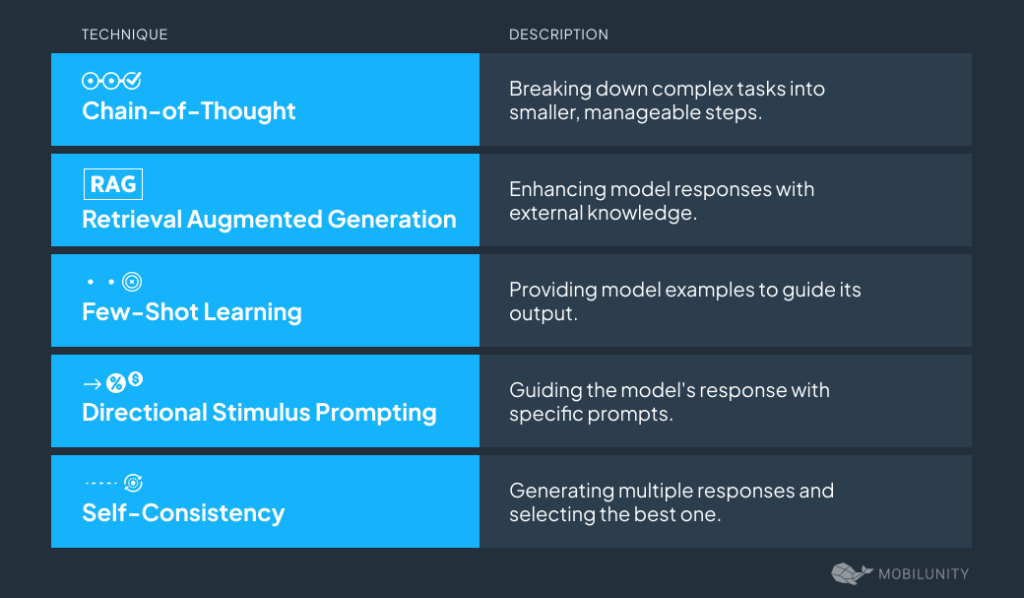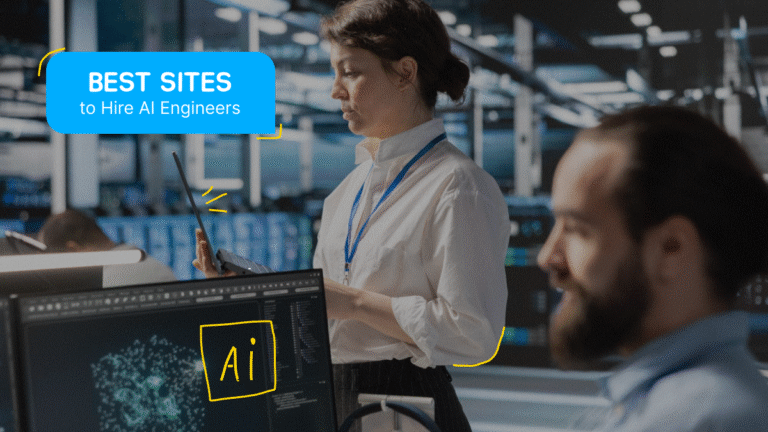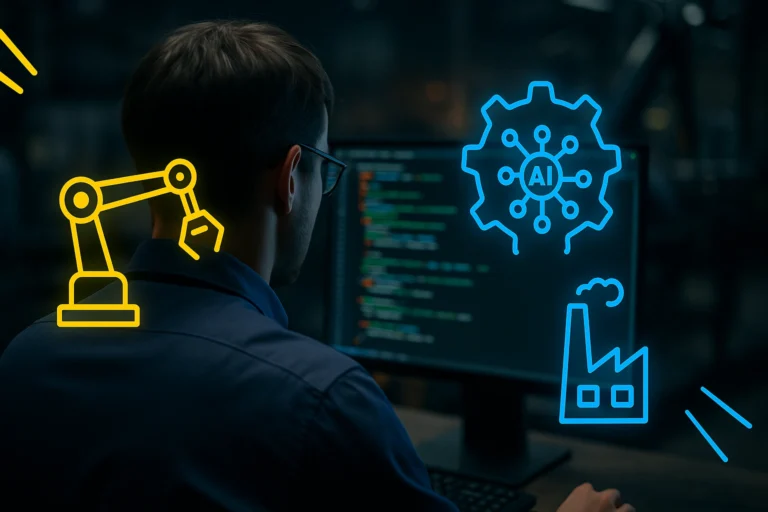An LLM Engineer: A Handbook On The Discipline
We already have our personalized virtual assistants generating human-like texts, understanding the context, extracting necessary data, and interacting as naturally as humans.
It’s all possible thanks to LLM engineers – people, responsible for building the next generation of smart systems.
While we’re chatting with our ChatGPT, Bards (now – Geminis), and Copilots, those models grow, learn, and develop.
Meanwhile, companies and organizations globally are keeping up with this technology trend.
The recent McKinsey report indicates that the Generative AI (which the Large Language Model is) surged up to 72% in 2024, proving reliability and driving innovation to businesses.
So, what does it take to be a mighty creator and whisperer of models and data sets?
In this article, we’re going to explain what businesses should consider when hiring an LLM developer, from skills and responsibilities to their impact across teams and different industries.
The Fundamentals: LLM Engineering And Its Business Values
Let’s look at how LLMs work from all perspectives.
What’s there for your business?
For starters, let’s address the advantages of LLM engineering. Why should companies apply it across their processes?
In addition to obvious values like enhanced customer experience, personalization, automation, and optimization, there are also hidden ones, or at least not so direct:
Risk assessment. Large language models can run through, research, and interpret large amounts of text data like reports and financial statements, to recognize trends and map out possible risks. This knowledge enables companies to predict different cases including market shifts or compliance challenges and simplifies addressing potential troubles. Overall, the technology levels up risk management and assessment, contributing to safer decisions.
Knowledge management. Models do a great job of sorting, retrieving, and summarizing bulks of information, which is invaluable to operating company knowledge. Employees would easily find necessary answers or recap complex subjects, which would cross-team knowledge sharing. Saving employees’ time and providing information accessibility, LLM-driven solutions would keep teams efficient.
Product development. While processing customer feedback, industry reports, and market data, models translate those data into customers’ needs and opportunities for new products or services. Given the data, they also contribute to brainstorming product features or adjusting current ones to market, helping to develop a competitive product.
Decision support. With contextual recommendations based on patterns in data, LLMs are powerful backing system tools for companies’ C-levels, collecting and transforming complex data to deliver more precise understanding for timely decision-making. This data-driven transparency simplifies strategic decisions, so LLMs may sometimes substitute for some counseling jobs.
Internal system training. With an advanced LLM, businesses can assemble personalized training data or deliver round-the-clock assistance within internal systems to guide employees through tasks and processes. The technology will promote faster learning, higher productivity, and a better understanding of company tools and procedures.
The technical side of LLM engineering
Now, let’s identify what LLM engineering means in general and take a look at its inner workings.
LLM Engineering is the technology-precise process of developing, fine-tuning, and deploying large language modes (LLMs) like GPT (Generative Pre-trained Transformer) from OpenAI, BERT (Bidirectional Encoder Representations from Transformers) by Google AI, LLaMa ( Large Language Model Meta AI), and others.
These models are built to capture and generate human language, which makes them a strong toolset for a large variety of applications, such as human-like content creation, question-answering systems, image captioning, etc. To operate appropriately and perform specific tasks, LLMs are trained on vast amounts of data.
We can say that a large model is a great learner. The more experimentation it involves and the more you instruct it, the deeper understanding of the language it has.
Basically, the concept of LLM development falls into creating and adjusting those advanced models to manage all language-related jobs efficiently.
At the same time, prompt engineering is an integral part here.
LLM prompt engineering is the process of preparation and refinement of the inputs – the prompts from a developer to a large language model to encourage the LLM for the best possible output – response for particular tasks. Its main goal is to significantly improve the performance and accuracy of the model’s output. Providing clear instructions and thinking step by step, they get the best of it.
The whole prompt engineering process can be divided into 3 steps:
- The prompt design: creating a precise input question or a statement for the model;
- The prompt test: running the prompt through the model to analyze its reply;
- The prompt refinement: Modify the prompt wording and structure to enhance the model output within reasoning steps and create the desired outcome.
Although the process seems simple at once, it’s important to note that the prompt must be specific but straightforward enough for a neural network to grasp and answer it. There are multiple approaches to prompt development applied to optimize the inputs for models, and each of them requires several iterations.
Here are some of the most common ones:

Of course, those above are only a few strategies. Prompting engineering methodology is quite an evolving area that has much more to offer.
To summarize:
- LLM engineering covers a broader scope of work like building and supporting large language models.
- Prompt engineering elaborates on specific aspects of framing entries and asking the right questions to maximize the model’s accuracy.
Generally, they work side by side to provide an appropriate model performance across multiple applications.
An LLM Engineer: What You Should Know When Hiring One
When hiring an LLM engineer, businesses have some expectations about what this role includes, its required skills, education, future development, and costs needed.

Role and responsibilities
Data preparation and management. LLM engineers start with collecting and arranging the proper data. They clean, organize, and schedule big datasets to provide the model with quality information to learn from. The qualification of this stage directly affects the future model performance.
Model development and fine-tuning. Upon the data preparation, a language model developer usually designs and trains the model. They elaborate on the model to fit precise business needs, adjusting it to a particular business vector, with the required information or responses. Such fine-tuning contributes to model accuracy for the present task.
Performance optimization. Throughout the development, engineers constantly refine the model to improve its efficiency, speed, and capacity for bigger request volumes. Such optimization minimizes costs, cuts response times, and provides the model scalability for real-world business scenarios.
Application and integration. Once developers arrange a suitable performance with a fine-tuned model, they merge it into current systems, providing fast accessibility and usability. This stage implies adjusting the model to business workflows to guarantee its value and seamless integration within the company’s tech infrastructure.
Research. LLM engineers stay in the loop of recent domain developments to learn new approaches for their existing models or further applications. Thus, models will remain relevant to technology evolution while keeping the business afloat.
Ethical concerns. Model makers consider ethical issues like eliminating bias or hallucinations and providing liable artificial intelligence use at every model development stage. Their job implies designing accurate and fair models to build trust with users and bypass possible ethical risks for the business.
Cross-team collaboration. During the entire process, experts cooperate across different teams, including data scientists, product managers, and stakeholders to keep everyone on the same page. Such cooperation confirms the alignment of the model’s capabilities to business needs and efficient feedback imprint.
Skills
Data preprocessing. LLM experts usually have a knack for systematizing and cleaning raw data to prepare it for model training. This would ensure the model’s education from appropriate, high-quality data to avoid mistakes and contribute to the model’s accuracy for real-world scenarios.
Natural Language Processing. This skill enables developers to build models that grasp human language (text or speech) in a commercially viable way. Thus, the model would comprehend and reply to customer queries, analyze feedback, or complete other language-related tasks.
Machine Learning and Deep Learning. This knowledge allows engineers to create models able to learn from data and improve with time. It secures the model’s accuracy, efficiency, and adaptability to provide trustworthy results for multiple business needs.
Transformer architecture. It’s the cornerstone of large language models which enables them to process lengthy, complex texts. Experts need this knowledge to design powerful models for text interpretation and generation, driving tasks like summarization, content generation, etc.
Attention mechanisms. Developers apply this technique within transformer models to enable the model to focus on the most suitable parts of the data. Hence, the model’s ability to accurately respond to complex questions improves, which optimizes it for particular business cases.
Programming languages. Language model experts are implied to have a strong knowledge of programming languages like Python combined with frameworks PyTorch and TensorFlow. Such a blend strengthened with other AI development tools empowers developers for the code fueling these models. They use it for the entire development process, securing efficient model functions and adaptation to business needs.
Model fine-tuning. The skill covers refining a pre-trained model to complete precise tasks or satisfy specific business demands. This method of adjustment allows model developers to enhance its accuracy and make it more customized to specific applications.
Cloud computing. The technique opens access to the high storage and processing power required for LLM training, testing, and deployment. Model makers need it to manage large data and computing requirements without overwhelming business resources.
API development. This bridge between the model and other software opens access to the model itself for users or other applications. The API technology provides swift model integration and application across different business systems.
Analytical thinking. LLM engineers are supposed to break down complex problems into doable components, which is necessary when searching for the best way to design the model. Strong analytics is required to guarantee the model’s ability to fulfill business needs, handle specific tasks, and deliver clear solutions.
Project management. The skill allows developers to keep focused on multiple aspects including timeline, budget, and cross-team collaboration. Thus, it confirms the alignment of model development with business objectives and coordination for everyone involved.
Education and certification
You don’t appear in this world being a ready-made LLM engineer. It takes obtaining skills and education to go through.
Higher education base. Each of the following educational backgrounds equips future model innovators with skills that guide LLM-related tasks in one way or another.
- Computer Science (Bachelor’s degree) offers a solid basis in programming, algorithms, and problem-solving. Here, developers get the basics of how models operate and skills for efficient software development and troubleshooting.
- Electrical Engineering (Bachelor’s degree) gives students fundamental aspects of computing and electronics. They will need it to comprehend hardware optimization, system efficiency, and the technical requirements of operating LLMs on cutting-edge computing systems.
- Artificial Intelligence (Master’s) suggests specific knowledge in machine language, natural language processing, and model design disciplines. It focuses on a model’s creation, adaptation, and improvement to handle typical business needs (automation, customer service, and data insights aggregation).
- Data Science (Master’s) aims at data processing, analysis, and interpretation. Its holders will skillfully prepare data, track model performance, and extract key business insights from large language models for data-driven decisions.
- Machine Learning (PhD) will provide deep knowledge of refined algorithms, model training, and advanced research. High-level positions leverage this background to focus on building new models, improving LLM technology, or guiding R&D processes in artificial intelligence.
Certifications. Often, engineers have already obtained solid model development backgrounds and skills throughout their careers. They only need to strengthen and confirm them for professional growth. Here’s when LLM certifications occur.
- Google Cloud Certified: Machine Learning Engineer. The certification delivers expertise in Google Cloud’s machine learning tools, prioritizing building, training, and deployment of extensive models. Model makers striving to understand Google Cloud’s large data and model management capabilities will appreciate it most of all.
- AWS Certified Machine Learning – Specialty. With the AWS platform being popular for AI/ML projects, the certification gives strong knowledge of ML implementation, optimization, and deployment on the AWS platform. It aims at language model creators involved in large-scale model processing on AWS.
- Microsoft Certified: Azure AI Engineer Associate. This certification provides a solid background in implementing smart solutions on Microsoft Azure, prioritizing NLP, computer vision, and ML pipelines. It’s the most reasonable for LLM engineers employing Azure’s infrastructure and services.
- IBM Certified AI Engineer Professional Certificate. These course materials focus on providing a wide scope of AI skills, such as deep learning and language processing. It targets developers exploring the foundations of AI, focusing on LLMs and IBM’s distinctive tools and platforms.
- Hugging Face Certified. Hugging Face itself is a favored platform among NLP and LLM engineers, providing them with pre-trained models and tools. The certification gives developers a strong understanding of language models, model fine-tuning, and other popular tools relevant to LLM development.
Jobs and prospects
As you’ve probably noticed, the role of an LLM engineer is to comprehend multiple responsibilities, skills, and expertise. It can transform and grow into different roles, each applying language models (like those of LLaMa, Claude, or Hugging Face transformers) to support, improve, and direct evolving business environments.
Prompt engineer. If a developer considers themselves a beginner in large model creation, this is a good start. These people design and optimize the questions and commands for interaction with models. The role focuses on improving the model response efficiency as to user inputs, providing higher precision and relevance in outputs within a continuous iterative process.
LLM application engineer. They build LLM applications, elaborating on model integration into software systems and providing good performance and business alignment.
LLM infrastructure engineer. This type of developer handles the technical side of the model’s training and deployment environment. They secure the computation accessibility and optimization for efficient model performance.
LLM product manager. These are watchers of the development and launch of LLM-empowered products. They coordinate teams, establish project goals, and confirm product-market fit and alignment with business strategy.
NLP engineer. With expertise in language processing, these engineers create systems able to understand and generate human language. They build applications that enhance user interactions with language-based data.
ML engineer. When you hire ML engineers, they focus on models’ design, building, and deployment, and elaborate on algorithms and data. They assemble systems that comprehend from experience and improve gradually, including those powering LLMs.
Data scientist. This kind of developer analyzes and interprets complex datasets to pull out insights that advise on business decisions. Data scientists operate with models to spot patterns and trends, sharing strategic recommendations.
AI research scientist. Highlighting research for AI domain improvement, the role also involves new algorithm development, study of innovative applications, and contribution to the scientific community while advancing the technology.
AI product manager. Just like a language model product manager but within a broader spectrum, the AI product manager handles products that apply smart intelligence. They balance technical capabilities with market needs, driving product development from ideation to launch.
AI solution architect. The role focuses on the design and implementation of AI systems suited to particular business challenges. AI solution architects provide business goals alignment and smooth architecture integration in existing technologies.
Conversational AI developer. Elaborating on chatbots and virtual assistants that use language models for interaction, these developers create systems for users to have natural conversations, which levels up customer support and user experience.
Data annotation and quality lead. These experts supervise labeling and curating data used in training models. They are responsible for valid and precise data to improve model performance and reliability.
Salary
Given the value of LLM engineering skills and responsibilities, it’s no surprise they are in high demand on the market.
To give a competitive offer to a high-skilled LLM expert, businesses should analyze their average rate.
Typically, the salary is influenced by multiple factors, such as:
- Location;
- Experience;
- Skills and specialization
- Education;
- Industry;
- Company size.
But we’ll look up on average.
The Glassdoor job board platform shows that the average base wage for an LLM engineer in the US is about $123,238/year, with total compensation (including bonuses and additional pay) estimated at $181,400 annually.
ZipRecruiter, meanwhile, reports $111,552 annually as the average earnings.
Indeed indicates figures between $104,000 and $189,750/year depending on their role and experience.
Yet, businesses looking to hire experts for this role should not only think of bare payment figures.
It’s about the whole compensation and benefits package (including stock options, equity, and performance bonuses). Often, it’s an equally important factor that can significantly impact the job searcher’s decision to accept the offer.
LLM Engineer In Different Industries And Real Use Cases
Talking about the expertise, we couldn’t but share some of Mobilunity’s valuable case study.
Data engineering for Latvian fintech startup
Latvian fintech startup reached Mobilunity to get help in hiring a skilled Data engineering expert in Python, SQL, and big data technologies (Hadoop and Spark). The goal was to launch a data-driven financial portal. Our team successfully recruited a candidate with all the required technical skills and also grasped the stringent data compliance and security demands of the fintech sector. The entire process lasted for three weeks, followed by a personalized onboarding process with a focus on security protocols and compliance training.
Below are the examples of LLM engineers’ assistance across more domains.
Healthcare
Building smart tools for patient data analysis and diagnosis assistants, these engineers raise efficiency in healthcare systems. Overall, this results in faster diagnoses, personalized treatment plans, and improved patient engagement.
Example: Curai Health, an AI-powered virtual clinic, uses LLMs to assist medical professionals with details on symptoms, probable diagnoses, and treatment recommendations.
Legal
These experts’ contributions to the legal sphere include systems for legal document review, research, and case management assistance. Their dedicated work streamlines legal processes, speeds up document analysis, and enables lawyers to prioritize more complex tasks, improving efficiency across the board.
Example: Luminance, a legal technology company, applies large language models to scan contracts, specify key clauses, and pinpoint any compliance issues, saving time for legal teams and reducing error risks.
Education
With modern education, efficiency is about tailored content and student support.LLM experts create such tools for personalized learning, grading, and tutoring systems that sweeten the general learning experience and help educators save time and improve results.
Example: With Khan Academy’s Khanmigo, using GPT-4, students get personalized learning guidance.
Challenges Of Finding A High-Skilled LLM Engineer
As with any data volume-related specificity, this kind of development has its twists and turns. We’ve outlined only several limitations of LLMs that tech companies should consider when hiring an LLM expert – and include them in budgeting.
Computational resources
Language models demand significant computing power and memory for efficient training and running. Such consumption may result in high infrastructure costs and the need for highly technological hardware, preventing smaller businesses from implementing LLM solutions.
Data management
Managing large data volumes is an integral part of the accurate LLM training process. Here, LLM developers are responsible for data quality, relevance, and compliance with privacy regulations. This blend is often time-consuming and resource-intensive.
Model complexity
This kind of model is highly complex and behaves unpredictably sometimes. Given that mistakes can result in poor performance or adverse effects, engineers are supposed to have deep knowledge of model tuning and optimization.
Operational blockages
Integrating LLMs into running systems can cause workflow disruptions. Engineers are accountable for technical challenges and possible resistance from staff, which can delay project timelines and raise costs.
Keeping up with advancement
Watching AI and LLM technologies developing with lightning speed, engineers have no other way than to continuously learn and train to stay relevant, which requires constant commitment.
Legal concerns
Large data volume comes with model bias and intellectual property, which may transfer into different legal and ethical issues. Navigation of such regulations requires precision and care to bypass legal penalties and secure responsible AI implementation.
The Future Of LLM Engineering
We don’t have a magic crystal ball to predict the future. Yet, recent trends with all advantages and limitations can help us envision the full potential of LLMs – with the support of businesses and institutions. The focus will be on enhancing efficiency, accuracy, and applicability across various domains.
- Progressive model efficiency and capability
- Autonomous prompt engineering
- Continuous learning
- Enhanced fact-checking and real-time data integration
- Integration of multimodal capabilities
- Application in software engineering
- Collaborative and trustworthy AI
- Focus on efficiency and sustainability
As we see, an LLM expert has a long way to go before becoming that one desirable talent. And with the growing demand and top-notch skills come responsibility and greater obstacles.
If you want to be sure that your advanced solution will launch and run smoothly, we’re always ready to help you find and hire an AI developer.
Don’t let your talent lack ruin your pursuit of innovation.













